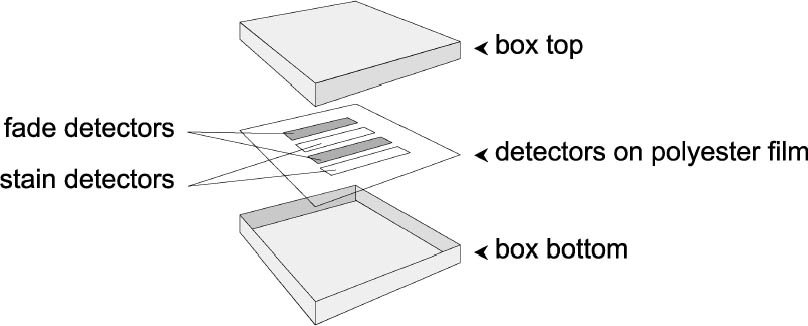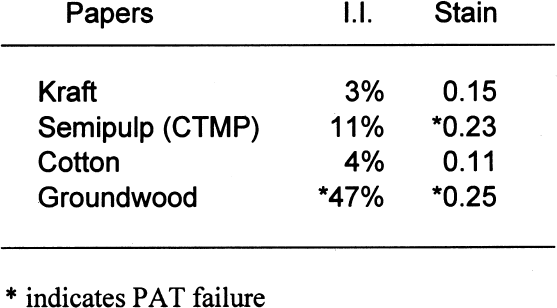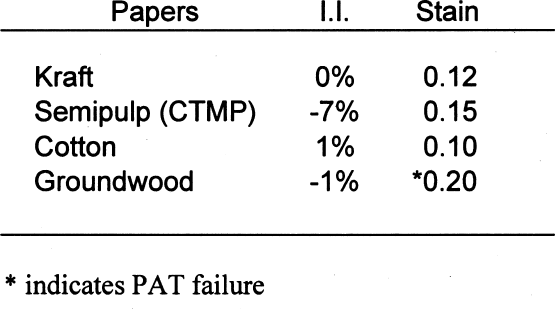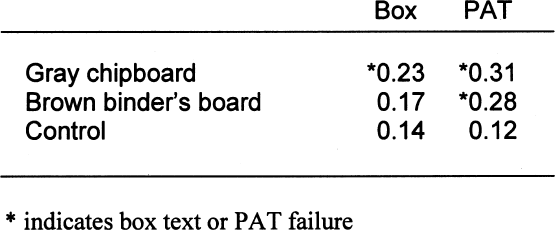EFFECTS OF ENCLOSURE PAPERS AND PAPERBOARDS CONTAINING LIGNINS ON PHOTOGRAPHIC IMAGE STABILITY
DANIEL M. BURGE, JAMES M. REILLY, & DOUGLAS W. NISHIMURA
4 RESULTS
4.1 PAPERS
Table 6 shows the results of the PAT on the four nonbuffered papers. Negative image interaction (I. I.) values indicate the percent difference that the sample detector faded more than the control (oxidation reactions). Positive image interaction values indicate the percent difference that the sample faded less than the control (oxidation and/or reduction reactions).
The standard states that the pass/fail limits for the image interaction portion of the test will be � 20% of the control. Of the four papers, only the groundwood paper failed the image interaction test. It is apparent that high lignins content results in adverse reactions with silver image particles.
Fig. 4.
Box test configuration
 |
Table .
Photographic Activity Test (PAT) Results for Nonbuffered Papers
 |
The standard states that the pass/fail limit for the stain portion of the test will be 0.08 density units above the control. In this case, the control result was 0.11; therefore, the stain limit is 0.19. Of the four papers, both the groundwood and the semipulp papers failed the gelatin stain test. This finding indicates that medium to high lignins content results in gelatin stain.
Table 7 shows the results of the PAT on the four buffered papers. Again, the pass/fail limits for the image interaction portion of the test are �20% of the control. None of the four papers failed the image interaction test. It appears that the inclusion of buffers in papers containing lignins can mitigate the adverse effects of lignins on silver image particles.
The pass/fail limit for the stain portion of the test is 0.08 density units above the control. In this case, the control result was 0.11; therefore, the stain limit is 0.19. Of the four papers, only the groundwood paper failed. This finding indicates that high lignins content may result in gelatin stain regardless of the inclusion of a buffer in the paper.
4.2 EXTRACTED PAPERS
It is not necessarily correct to assume that it is the lignins from wood pulps that cause all harmful reactions with photographs. There is still the question of the reactivity of the extractives. That these materials may be the harmful component of lignins-containing pulp may be moot. They seem to be removed in the delignification and bleaching processes. It is possible, though, that establishing these materials as potential sources of photoactivity may help papermakers produce lower-cost, quality papers in the future.
Tables 8 and 9 show the results of those tests. The removal of extractives significantly changed the
Table .
Photographic Activity Test (PAT) Results for Buffered Papers
 |
Table .
Image Interaction Results for Extraction Test
 |
Table .
Gelatin Stain Results for Extraction Test
 |
Table .
Image Interaction Results for Box Test
 |
Table .
Gelatin Stain Results for Box Test
 |
image interaction results for the nonbuffered groundwood paper. It appears from the data that it was either the extractives or extractives-lignins interactions and not just the lignins that caused the image interaction failure in the nonextracted groundwood sample. The removal of extractives did not change the gelatin staining results. This finding confirms lignins as the source of gelatin staining.
4.3 BOX TEST
In the above tests, the lignins-containing paper products were tested in intimate contact with the image interaction and gelatin stain detectors. This arrangement simulates the practice of housing images in direct contact with enclosures such as envelopes, sleeves, and mats. But what about products that do not come in contact with the images, such as slipcases, boxes, and album binders? Can harmful groundwood components in these materials act across the air spaces inside the box?
The boxboards were tested in the box test and in the PAT simultaneously to compare results. Note that in the PAT configuration the box material is in direct contact with the detectors. In the box test configuration, the test detectors are separated from the box material by 3 cm. Because of this air space, some reduction of the signal was expected. Also note that the control for the PAT was Whatman no. 1 filter paper, and the control for the box test was made from buffered, purified wood-pulp mat board. The results are shown in tables 10 and 11.
As expected, the boxes made from the gray chipboard and the brown binder's board failed the box test and the PAT in image interaction. However, the dilution of harmful contaminants in the box's air space did reduce the staining effect enough for the brown binder's board to pass the test. Still, it is clear from the results that lignins-containing paper products do not need to be in direct contact with the images in order to mar them. The density difference between the test detectors and the control test detectors was less for the box test than for the PAT. This finding is due to dilution of the harmful volatiles within the air space of the box. However, the harmful action still exists.
|